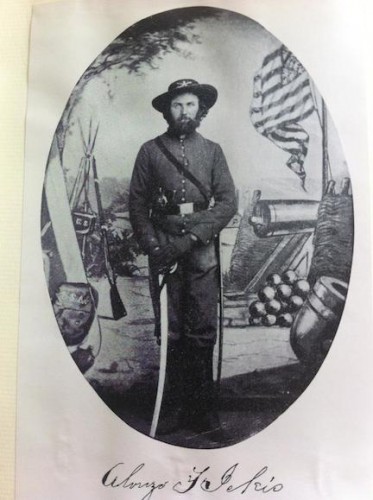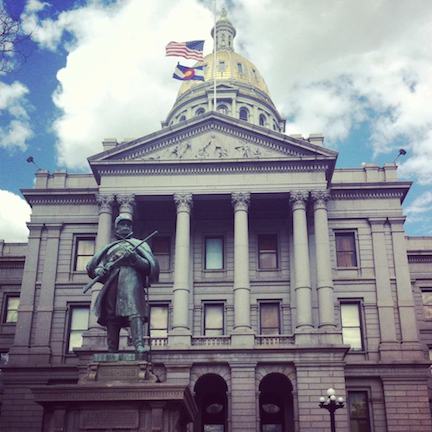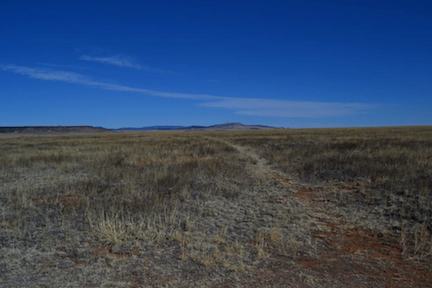Why do so few historians talk about the American Civil War in the West? And by “the West” I don’t mean the trans-Mississippi. I mean the vast stretches of high desert and the extensive mountain ranges west of the 100th meridian, where elevation and aridity make everything a bit more difficult: breathing, walking, growing crops, keeping animals alive and wagon wheels turning.
Some people assume that no one talks about the West because there weren’t any Civil War battles there. This isn’t true.

There were several clashes between Union and Confederate troops early in the war—at Valverde, and then at Apache Canyon and Glorieta Pass in New Mexico Territory in 1862. The armies here were miniscule (2,000-3,000 men) compared with the massive armies in the trans-Mississippi and the eastern theaters, but their battles were hard-fought, and definitive. And when the Confederates retreated Union troops continued their ongoing battles against Native peoples in the region; these were as significant to the Union war effort as campaigns against Confederates. The climate and topography shaped all of these fights to an unusual degree; we can learn a great deal about why military strategies succeed and fail in different landscapes by examining the Western theater.
Others—most conspicuously Gary Gallagher, in an interview with the Civil War Trust—say that no one talks about the West because we don’t need to: the wartime events there do not matter in the overall history of the conflict. Such a dismissive assertion cannot be taken seriously; and it isn’t true either.
In the 1840s and 50s, American politics of imperialism and the increasingly bitter sectional debates about the expansion of slavery were focused on the western territories. The imagined futures of these lands continued to shape both Union and Confederate nationalisms throughout the war, inform political decisions and legislative acts, and influence military strategies in all theaters.

Clearly, we need to talk more about the Civil War in the West. Some scholars have already begun to do so. Historians Donald Frazier, Jerry Thompson, and John Wilson have written about the Union and Confederate war efforts in the New Mexico and Arizona territories, while several scholars of western Native American history (Pekka Hämäläinen, Brian DeLay, and Karl Jacoby) have given some attention to the Civil War era in their books. Ari Kelman’s 2014 Bancroft Prize-winning A Misplaced Massacre argues for understanding the Civil War as an imperial enterprise in this region; and a forthcoming edited volume containing essays on the war and Reconstruction in the West (University of California Press, 2015) suggests that paying attention to the Civil War West reveals “a larger, unified history of conflict over land, labor, rights, and the limits of governmental authority in the United States.”
I will be adding my own voice to these conversations through my new book project, tentatively entitled Path of the Dead Man, which will weave together the wartime stories of Union and Confederate soldiers, Apaches, Navajos, and Southwestern civilians. Over the next few months I will be traveling throughout the West, doing research in state and university archives in Colorado, New Mexico, Arizona, and Texas. I will be reading through newspapers, letters, diaries, and business records, and looking at photographs, maps, material culture, and the landscape itself in order to determine the nature of the Civil War in the West.
I will also be driving (and sometimes biking) the region’s roads. Extraordinarily long marches over mountains and through deserts characterized the war in the West. Path of the Dead Man will be a military and a cultural history; it will also be an environmental history of landscapes of mobility. I will be tracking one Union soldier’s 1861 journey from Cañon City, Colorado to Santa Fe; following the route of the 1864 Long Walk of the Navajo from Canyon de Chelly, Arizona to Bosque Redondo, New Mexico; and tracing the many steps that Confederate General Henry Sibley’s Brigade took on their 1862 retreat from Albuquerque, New Mexico back to San Antonio, Texas.

I will be writing about archival finds and historic sites, and will be posting photo galleries as I go. The blog will become a kind of research diary and through it I will work out ideas and experiment with arguments and methodologies.
This doesn’t mean that Historista will now be all Civil War, all West all the time, however. I’m sure I’ll come across other weird and surprising things during this trip that I will feel moved to write about. And the next season of The Vampire Diaries begins on October 2.
I recommend Elliot West’s excellent “The Last Indian War,” on the Nez Perce war of 1877. West suggests that the Indian wars fit into a larger narrative of Reconstruction (not so much the Civil War, though). He argues that the victorious Union tried to remake both the South and the West in its own image. It’s a little far-fetched, but no more so than Ari’s putting Sand Creek within the War.
“Others—most conspicuously Gary Gallagher, in an interview with the Civil War Trust—say that no one talks about the West because we don’t need to: the wartime events there do not matter in the overall history of the conflict.”
I think this is half of the equation, MKN. And I believe the other is that as the West becomes part of the broader picture for Civil War historians, it simultaneously loses the ability to serve as a dumping ground for the characters and events that don’t fit snugly within “traditional” or “safe” renditions of the war. (Read: when we don’t want to talk about Native Americans or bushwhackers, they’re raiders and bandits of “the West” who just happened to be operating at the same time the war was going on…) Opening up the “island of misfit Civil War characters” means losing more and more of the war as so many have known it for so long, which creates natural generational friction… but in the long run, this sort of makeover will be the only way to really understand the true scope of the conflict and how it touched all sorts of different peoples in different ways.
MCH
If you haven’t read it yet, you should check out Susan Shelby Magoffin’s journal of her travels from St. Louis into Mexico in 1846. Fascinating stuff. Bernard DeVoto’s Year of Decision 1846 references that journal often.
Best of luck in your travels and research. I have one book on the topic and wonder how you rate it: Alvin M. Josephy, Jr., The Civil War in the American West (Knopf, 1991).
Thanks, Mark! Josephy’s book is a classic, as is Ray Colton’s *The Civil War in the Western Territories.* Really solid military history on both Union/Confederate clashes and Native/Union battles. No real attention to the environment, however, or larger arguments about imperialism.
Aw man! I wish I still lived in southern Colorado. Canon City was only about an hour away. If you want any restaurant recommendations or anything, you know where to find me!
This sounds like a fascinating project and if I can be of any use, don’t hesitate to ask. I can hook you up with some resources or contacts, perhaps.
How *dare* you move away right now? I mean, really. I’ll definitely be in touch (via email) about resources — thank you!
The war in the Southwest puts the Latino experience back into American history, which may be one reason it is ignored.
YES.
I did a series about the Battle at Picacho Pass, in Arizona, for the Emerging Civil War blog. Additionally, I went to the Presidio in San Francisco and found the two graves of men who were killed there and reinterred. Check out the posts! Glad to see someone is doing this as well.
Fabulous! Thanks for the tip, Meg!
Sounds awesome!
Let me know if you are in Mora looking at records (I think it is a the San Miguel County records— ). I’d be happy to pay you to take some pictures of some land records there that I did not document as well as I needed to.
There were also some interesting, immediate postwar excursions into Mexico, from Union soldiers in Texas.
I’ll let you know if I am! And yes–the Mexican borderlands were also a fascinating landscape of mobility. There were Natives, soldiers, and Mexicans/New Mexicans crossing back and forth, all the time …
Elliott West’s Contested Plains is good on this, too. Good luck with the project!
Yes! Love that book–and it is essential for explaining how Colorado could muster so many young men to fight for the Union. They had come to mine for gold in ’58-59 …
Hi Kate. Please stop by to say hello when you pass through Metro Phoenix. In any case, a definite stop of your itinerary should Picacho Pass, which is on I-10 between Phoenix and Tucson. It was the site of the western-most engagement of the war. A skirmish really, but a definite place to stop since it so accessible.
Alas, I’ll be in southern Arizona this time around. And yes–Picacho Pass is *definitely* on the itinerary!
Your research sounds fascinating — wishing you well in your travels and discoveries! I am amazed by how many Civil War stories are as yet untold, even 150+ years later. Look forward to reading about your findings.
Thanks, Christy! It is remarkable, isn’t it, how much there is left to discover? And it is all important to understanding the war writ large.